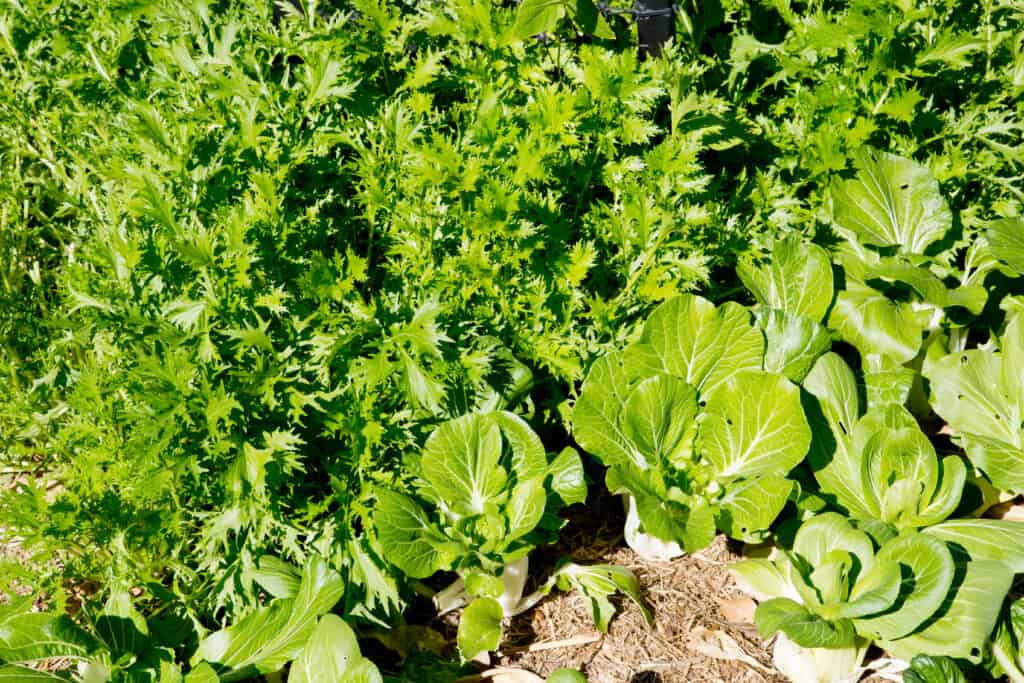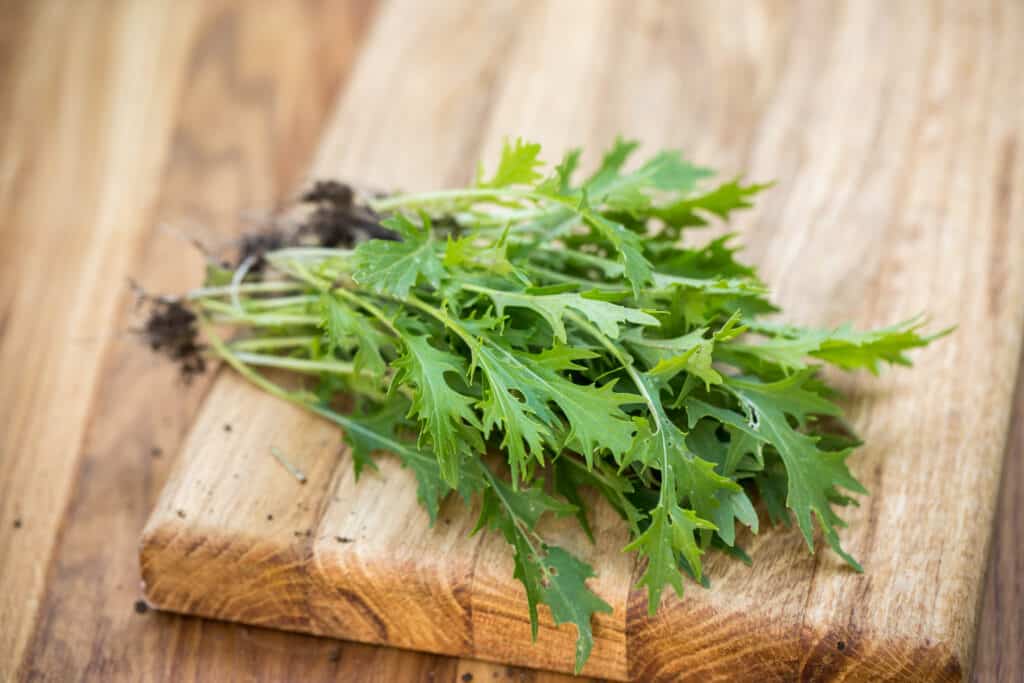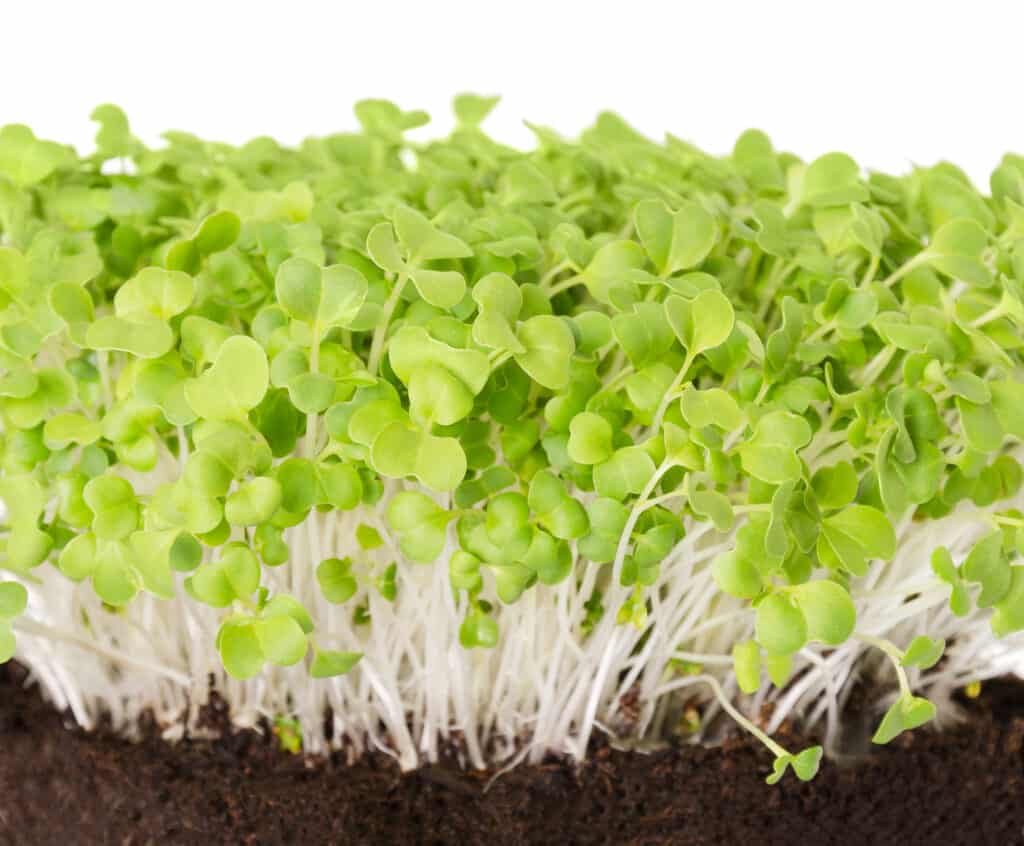Mizuna is an Asian leafy green well suited for salads or salad mixes such as mesclun. Mizuna can also be used in stir-fries and soups and added to other dishes at the end of cooking. Mizuna is similar to mustard greens though milder flavored—a bit peppery, tangy, and with a light cabbage flavor.
Mizuna is best grown in cool weather, but unlike many leafy greens, it is slow to bolt in hot weather. Sow mizuna in the garden in spring as soon as the soil can be worked. It will germinate in the soil as chilly as 40°F (4°C). It can be started indoors early for transplanting out mid-spring just before the last frost. Also, grow mizuna in the garden in the fall and in a plastic tunnel or cold frame for harvest through the winter.
Related articles:
- Ways to Prepare and Serve Mizuna
- Six Ways to Cooke and Serve Mustard Greens
- 40 Chinese Vegetables to Grow
- How to Plant, Grow, and Harvest Mizuna
Here is your complete guide to growing mizuna:
Where to plant mizuna
- Plant mizuna in full sun.
- Plant mizuna in humus-rich, well-drained soil. Add aged compost to the planting area before planting.

When to plant mizuna
- Mizuna grows best in cool weather.
- Sow seed or set out transplants in mid-to late spring for harvest before the weather turns hot in summer.
- Sow mizuna seed every three weeks for a succession of harvests; mizuna grows from seed to maturity in 40 days.
- Plant mizuna again near the end of summer for harvest in the cool weather of autumn and early winter.
- Mizuna can tolerate frost near maturity.
- Grow mizuna through winter in a plastic tunnel or cold frame.
Good Products at Amazon for Raised Bed Growing:
- Galvanized Raised Bed 8×3
- Cedar Raised Bed 4×8
- Elevated Cedar Planter 4×2
- Walk-In Greenhouse Tunnel 15x7x7
- Row Cover for Freeze Protection 10×30
Planting and spacing mizuna
- Sow mizuna seed ¼ to ½ inch (6-13 mm) deep.
- Space mizuna 8 to 10 inches (20-25 cm) apart if you are growing plants for a harvest of leaves cut and come again.
- If you are sowing mizuna to be harvested as a microgreen then you can broadcast seed and thin small plants for eating and let others grow to maturity. Microgreens can grow as close as 1 inch (2.5 cm) apart.
- Mizuna is a good choice for interplanting in the shade of slower-maturing crops.
- Mizuna yield: Three or four plants will provide plenty of cut-and-come-again leaves for salads.
Container growing mizuna
- Mizuna, like most greens, is easily grown in containers. Choose a container at least 6 inches deep and wide.
- Grow mizuna in well-draining potting soil.
Watering and feeding mizuna
- Keep the soil evenly moist; not too wet and never completely dry.
- During the growing season feed mizuna with dilute fish emulsion especially if you heavily harvest individual plants.
Good Products at Amazon For Growing Mizuna and Cabbage Family Crops:
- Neem Bliss 100% Cold Pressed Neem Oil
- Monterey BT Caterpillar Killer
- Safer Brand Insect Killing Soap
- PyGanic Botanical Insecticide
- Captain Jack’s Dead Bug Brew
- Live Ladybugs
- Natures Good Guys Beneficial Nematodes
- Yellow Sticky Traps
- Southern Ag Liquid Copper Fungicide
- MycoStop Biofungicide
Mizuna pests and diseases
- Flea beetles can attack mizuna; protect plants with row covers. Put row covers in place right after seeding.
- To avoid cabbage-family-related diseases, do not plant mizuna after cabbage or other cabbage family crops.

Harvesting mizuna
- Mizuna can be harvested small as a microgreen or you can wait until leaves are 3 to 4 inches (8-10 cm) long. Clip leaves with garden scissors.
- Larger mizuna leaves can be harvested, but harvest leaves while they are tender and before they grow a bit tough with age, especially in warm weather. Use older leaves in stir-fries, soups, and cooking.
- You can harvest all of the leaves from a single plant about an inch above the soil and the leaves will regrow for a second harvest.

How to Use mizuna in the kitchen
- Mizuna can be added to stir-fries and soups.
- Mizuna is often an ingredient in the salad mix called mesclun or spring mix; other greens often found in mesclun are arugula, dandelion, frisée, mâche, radicchio, endive, and sorrel.
Mizuna varieties to grow
- Varieties. ‘Kyona Mizuna’: rosettes of thin, deep cut, feathery, fringed leaves, mild flavor; ‘Purple Mizuna’: green leaves with purple margins.
About mizuna
- Botanical name. Brassica rapa var. juncea; Mizuna is a member of the cabbage family, Cruciferae.
- Origin. China; mizuna has been grown in Japan for centuries and is also called kyona-greens, named after Kyoto, the ancient Japanese capital.
Related articles:
How to Prepare and Serve Mizuna
Related articles:
How to Plant, Grow, and Harvest Chinese Cabbage
Five Ways to Cook and Serve Chinese Cabbage
Four Ways to Cook and Serve Napa Cabbage
Five Ways to Cook and Serve Bok Choy
How to Plant, Plant, Grow, and Harvest Mizuna
Ways to Prepare and Serve Mizuna
How to Cook and Serve Bitter Melon
Articles of interest:
Best Herbs for Container Growing
Garden Planning Books at Amazon:
- Vegetable Garden Almanac & Planner
- Kitchen Garden Grower’s Guide Vegetable Encyclopedia
- Vegetable Garden Grower’s Guide
- Tomato Grower’s Answer Book
More how to grow articles:
Learn how to plant, grow, and harvest your favorite vegetables. Click below for all you need to know.
- Artichoke
- Arugula
- Asparagus
- Beans, Snap
- Beets
- Broad Beans
- Broccoli
- Brussels Sprouts
- Cabbage
- Cantaloupe — Melons
- Cardoon
- Carrots
- Cauliflower
- Celeriac
- Celery
- Chard
- Chayote Squash
- Chickpeas
- Chicory
- Chinese Cabbage
- Collards
- Corn Salad
- Corn, Sweet
- Cresses
- Cucumbers
- Eggplant
- Endive and Escarole
- Fava Beans
- Florence Fennel
- Garbanzo Beans
- Garlic
- Horseradish
- Jerusalem Artichoke
- Kale
- Kohlrabi
- Leeks
- Lettuce
- Lima Beans
- Melons
- Mizuna
- Mustard Greens
- New Zealand Spinach
- Okra
- Onions
- Parsnips
- Peanuts
- Peas
- Peppers
- Potatoes
- Pumpkins
- Radicchio
- Radishes
- Rhubarb
- Rutabaga
- Salsify
- Shallots
- Sorrel
- Southern Peas
- Soybeans
- Spinach
- Squash, Summer
- Squash, Winter
- Sunchokes
- Sweet Potato
- Swiss Chard
- Taro
- Tomatillo
- Tomatoes
- Turnips
- Watermelon
- Zucchini















